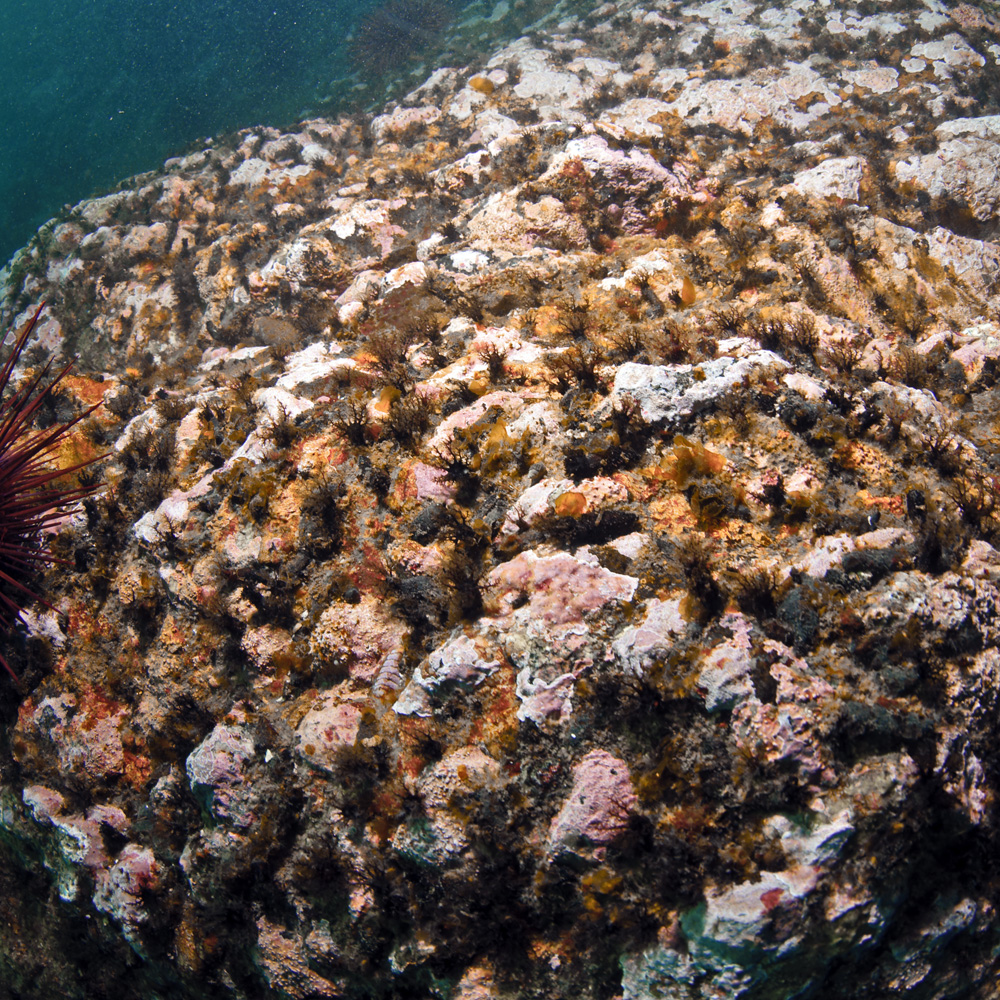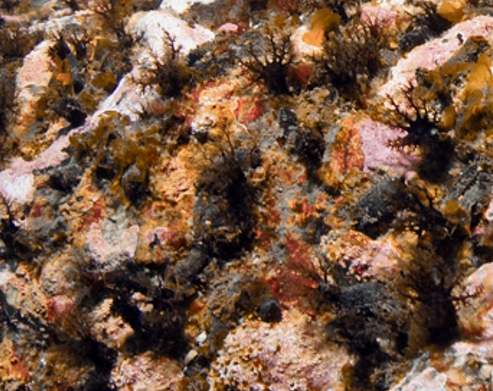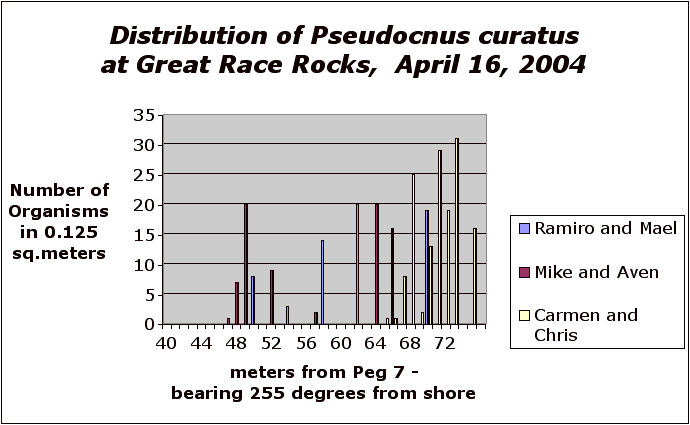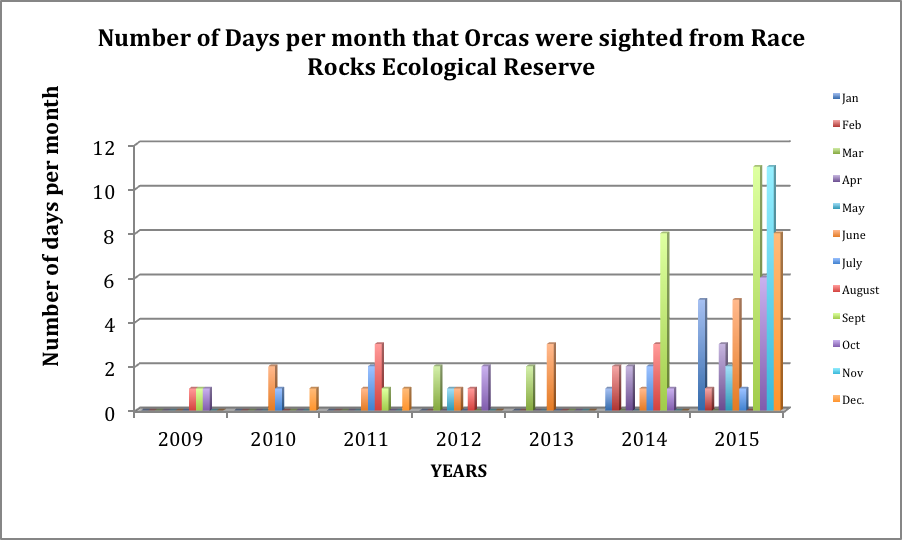 by Ryan Murphy, April, 2010 See Ryan’s underwater set on Flickr with a range of invertebrates: by Ryan Murphy, April, 2010 See Ryan’s underwater set on Flickr with a range of invertebrates:
In the early 1980’s while doing subtidal surveys, we discovered a major concentration of the small subtidal sea cucumber Pseudocnus curatus ( formerly Cucumaria pseudocnus) living in high density off the West side of Great Race Rocks. On April16, 2004, six divers, Ramiro, Mael, Mike, Carmen, Aven and Chris were able to do a preliminary survey of the area and have produced the results shown here.
To do the survey, they ran out a reel tape measure from shore to 75 meters in a bearing of 255 degrees magnetic from peg number 7- a permanent reference peg on the very South West corner of the Island. This took them into water that is 8 to 10 meters in depth.
We are uncertain as to why this organism concentrate here in these numbers, and this also happens at other locations such as Beecher bay 3 km to the West. This is the only area we find them in at Race Rocks.
Also included in this file are the raw data values from the divers. One may clip and paste these into an EXCEL program in order to do alternate analysis.
 This species is distinguished from Cucumaria pseudocurata which lives up in the mussel beds by having 10 tentacles instead of 8. It is s found in great abundance on the surface of boulders at a depth of 10 meters 60 meters offshore of the south west tip of Great Race Rock ( peg7) Counts of up to 1000 per square meter have been estimated. It can also be found intertidally among the mussel beds on the Western side of the main island. This species is distinguished from Cucumaria pseudocurata which lives up in the mussel beds by having 10 tentacles instead of 8. It is s found in great abundance on the surface of boulders at a depth of 10 meters 60 meters offshore of the south west tip of Great Race Rock ( peg7) Counts of up to 1000 per square meter have been estimated. It can also be found intertidally among the mussel beds on the Western side of the main island.
The following count done by students of the diving activity gives an idea of how dense this species is in one location at Race Rocks. Recently Ryan Murphy found another population of this density on the Eastside of Great Race Rock.
 The book Sea Cucumbers of British Columbia, Southeast Alaska, and Puget Sound by Phil Lambert is the best source for identification of most of the 45 species of local sea cucumbers. In it he notes that the habitat of Pseudocnus curatus “in the Juan de Fuca Strait tends to be shallow subtidal in areas where the tidal currents are strong….. They nestle together in large aggregations on open rocky surfaces …..and….. are eaten by many species of sea stars……although their body wall is toxic to some fish predators providing a strong defense mechanism.” The book Sea Cucumbers of British Columbia, Southeast Alaska, and Puget Sound by Phil Lambert is the best source for identification of most of the 45 species of local sea cucumbers. In it he notes that the habitat of Pseudocnus curatus “in the Juan de Fuca Strait tends to be shallow subtidal in areas where the tidal currents are strong….. They nestle together in large aggregations on open rocky surfaces …..and….. are eaten by many species of sea stars……although their body wall is toxic to some fish predators providing a strong defense mechanism.”
See also Taxing Problems by Philip Lambert – Now Curator Emeritus of Invertebrates, Royal BC Museum for a description of the difficulty in classification and the need to classify by the skin ossicles.
Google Pseudocnus curatus for a link to the page describing this species..
Pseudocnus curatus Is similar to another species, Cucumaria pseudocurata which is found more shallow in the intertidal zone at Race Rocks. Both species average 1.5 to 3cm in length. C. pseudocurata has 5 bands of tube feet in single or zig zag rows. As a rule there are 8 equal sized tentacles. P.curatus on the other hand has 10 equal sized tentacles. and tube feet scattered on the Dorsal side. At Race Rocks, it lives in the subtidal zone at 8 to 10 meters in depth.
|
Domain Eukarya
Kingdom Animalia
Phylum Echinodermata
Sub-Phylum Eleutherozoa
Class Holothuroidea
Subclass Dendrochirotacea
Order Dendrochirotida
Family Cucumariidae
Genus Pseudocnus
Species curatus, (Lambert,1997?)
Common Name: Black brooding sea cucumber
POPULATION DISTRIBUTION at RACE ROCKS
| In the early 1980’s while doing subtidal surveys, we discovered a major concentration of the small subtidal sea cucumber Pseudocnus curatus ( formerly Cucumaria pseudocnus) living in high density off the West side of Great Race Rocks. On April16, 2004, six divers, Ramiro, Mael, Mike, Carmen, Aven and Chris were able to do a preliminary survey of the area and have produced the results shown here. |
| To do the survey, they ran out a reel tape measure from shore to 75 meters in a bearing of 255 degrees magnetic from peg number 7- a permanent reference peg on the very South West corner of the Island. This took them into water that is 8 to 10 meters in depth. |
| We are uncertain as to why this organism concentrate here in these numbers, and this also happens at other locations such as Beecher bay 3 km to the West. This is the only area we find them in at Race Rocks. |
| Also included in this file are the raw data values from the divers. One may clip and paste these into an EXCEL program in order to do alternate analysis. |

| Raw Data from 0.125 meter quadrats |
Ramiro and |
Mike and Av |
Carmen and Chris |
| meters from the shore 40 |
|
|
|
|
| 41 |
|
|
|
|
| 42 |
0 |
|
|
|
| 43 |
|
|
|
|
| 44 |
|
|
|
|
| 45 |
|
|
|
|
| 46 |
0 |
|
|
|
| 47 |
|
1 |
|
|
| 48 |
|
7 |
|
|
| 49 |
|
20 |
|
|
| 50 |
8 |
|
|
|
| 51 |
|
|
|
|
| 52 |
|
9 |
|
|
| 53 |
|
|
|
|
| 54 |
3 |
|
|
|
| 55 |
|
|
|
|
| 56 |
|
|
|
|
| 57 |
|
2 |
|
|
| 58 |
14 |
|
|
|
| 59 |
|
|
|
|
| 60 |
|
|
|
|
| 61 |
|
|
|
|
| 62 |
20 |
|
|
|
| 63 |
|
|
|
|
| 64 |
|
20 |
|
|
| 65 |
|
|
1 |
|
| 66 |
16 |
|
1 |
|
| 67 |
|
|
8 |
|
| 68 |
|
|
25 |
|
| 69 |
|
|
2 |
|
| 70 |
19 |
|
13 |
|
| 71 |
|
|
29 |
|
| 72 |
|
|
19 |
|
| 73 |
|
|
31 |
|
| 74 |
|
|
0 |
|
|
 by Ryan Murphy, April, 2010 See Ryan’s underwater set on Flickr with a range of invertebrates:
by Ryan Murphy, April, 2010 See Ryan’s underwater set on Flickr with a range of invertebrates:






